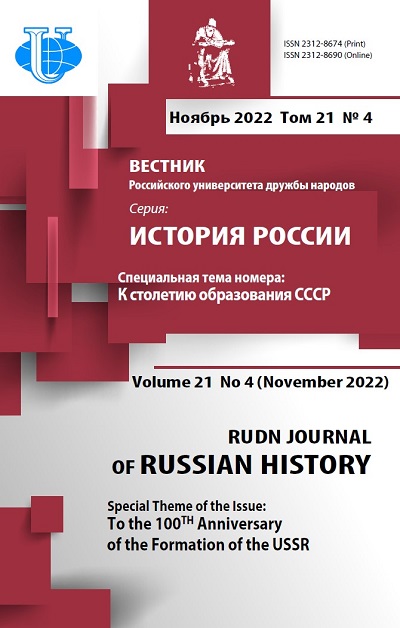The Prisoner Camp System in the Caspian Region of Kazakhstan in 1932-1940
- Authors: Ivanova G.M.1
-
Affiliations:
- The Institute of Russian History of the Russian Academy of Sciences
- Issue: Vol 21, No 4 (2022): To the 100th Anniversary of the Formation of the USSR
- Pages: 498-508
- Section: TO THE 100TH ANNIVERSARY OF THE FORMATION OF THE USSR
- URL: https://journals.rudn.ru/russian-history/article/view/32795
- DOI: https://doi.org/10.22363/2312-8674-2022-21-4-498-508
Cite item
Full text / tables, figures
Abstract
In the study of the history of Soviet camps, there are still serious gaps; in particular, there are no works that reveal the history of the creation and functioning of the camp system in the Caspian region. This study fills the gap in historiography and provides answers to the topical issues of the location of some camp units, reasons, goals, objectives and conditions for the creation and operation of the camp com-plex in the Kazakhstan region of the Caspian Sea. The source base of the study is the documents from the fund of the Main Directorate of Camps and Places of Incarceration of the Ministry of Internal Affairs of the USSR of the State Archive of the Russian Federation. The article shows that from the middle of 1932, in the course of solving the problem of creating their own supply base, the OGPU camps began to intensively develop the fishing industry. The GULAG got a new fishing area - Prorva located in the north-eastern part of the Caspian Sea. For catching and processing fish, there was created the Prorva labor camp which functioned from 1932 to 1940; it was initially subordinated to the GULAG OGPU and stationed in the Kazakh ASSR on the island of Prorva in the Caspian Sea. One of the largest units was the Guryev camp with the population of up to 2 thousand people; it was located in the area of the town of Guryev, Kazakh ASSR. The prisoners were engaged in fishing and provided them-selves with fish, the supply of which to the camps was cut off from 1932. The study reveals that the prisoners settled down in the Caspian fishing region of Kazakhstan in extremely difficult climatic, living and working conditions; they made a significant contribution to the provision of camps and colonies with food, since all products manufactured by the Prorva labor camp were sold in the GULAG system.
Keywords
About the authors
Galina M. Ivanova
The Institute of Russian History of the Russian Academy of Sciences
Author for correspondence.
Email: iriran@mail.ru
ORCID iD: 0000-0002-3784-5619
Dr. Habil. Hist., Chief Research Fellow, Center for Social History of Russia
19, Dmitriya Ulyanova Str., Moscow, 117292, RussiaReferences
- Akhmetova, U.T., Mukhtar, A.K. “From the history of the labor correctional camp Prorva (1932-1950).” II Study of the native land: its importance and priorities: Proceedings of the Republican online scientific-practical conference (May 15, 2020). Atyrau-Saraishyk: [N.s.], 2020 (in Kazakh)
- Akhmetova, U.T., Zhumabaev, A.Zh. “Prorva camp in the Gulag system (1932-1950).” Bulletin of WKSU, no. 3 (2020): 138-146 (in Kazakh). https://doi.org/10.37238/1680-0761.2020.79(3).14
- Bacon, Ed. The Gulag at War: Stalin’s Forced Labour System in the Light of the Archives. New York: New York University Press, 1994
- Bolonina, L.V. “Creation of the Prorvinsky forced labor camp in the Astrakhan region and its production and economic activities.” In Crossroads of history. Actual problems of historical science: Proceedings of the XII International Scientific and Practical Conference, Astrakhan, April 29, 2016, 76-79. Astrakhan: Individual entrepreneur Sorokin Roman Vasilievich, 2016 (in Russian)
- Chernavin, V.V. Notes of the “wrecker”. Escape from the Gulag. St. Petersburg: Canon Publ., 1999 (in Russian).
- David-Fox, M., ed. The Soviet Gulag: Evidence, Interpretation, and Comparison. University of Pittsburgh Press, 2016.
- Gvozdkova, L.I. History of repressions and Stalin's camps in Kuzbass. Kemerovo: Kuzbassvuzizdat Publ., 1997 (in Russian).
- Ivanova, G.M. GULAG in the system of a totalitarian state. Moscow: MONF Publ., 1997 (in Russian).
- Ivanova, G.M. The history of the GULAG: 1918-1958. Moscow: Politicheskaya Entsyklopedia Publ., 2015 (in Russian).
- James, R. Harris. “The Growth of the Gulag: Forced Labor in the Urals Region, 1921-1931.” The Russian Review 56, no. 2 (1997): 265-280.
- Kokurin, A.I., Petrov, N.V. “GULAG: structure and personnel.” Free thought, no. 8 (1999): 109-126 (in Russian).
- Korelskiy, V.P. In my time: Memories, traditions of the family, reflections. Arkhangelsk: Pravda Severa Publ., 1996 (in Russian).
- Morozov, N.A. GULAG in the Komi region. 1929-1956. Syktyvkar: Komi book Publishing House, 1997 (in Russian).
- Tanasiychuk, V.N. “The road to Dzhurun and back.” Star, no. 11 (1998): 202-214 (in Russian).
- Tanasiychuk, V.S. “Arrests at the Murmansk biological station in 1933.” Repressed Science. Issue 2, 306-318. St. Petersburg: Nauka Publ., 1994 (in Russian).
- Udovenko, I.V. “The camp system of places of detention in the Moscow region (1918 - the end of the 1930s).” In History of Russia from ancient times to the 21st century: problems, discussions, new views, 204-211. Moscow: Institute of Russian History RAS, 2018 (in Russian)
















